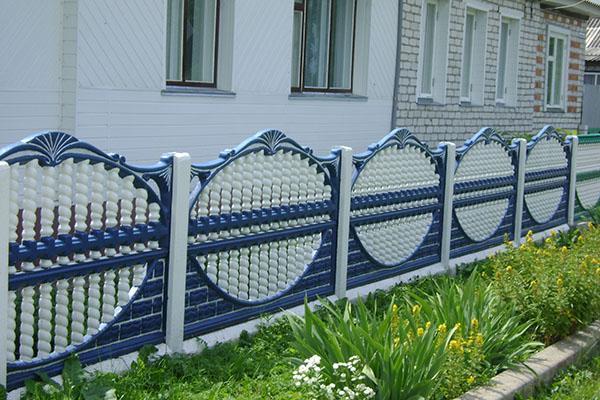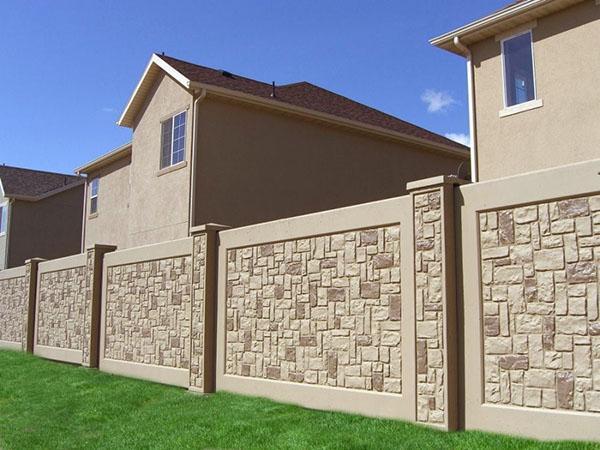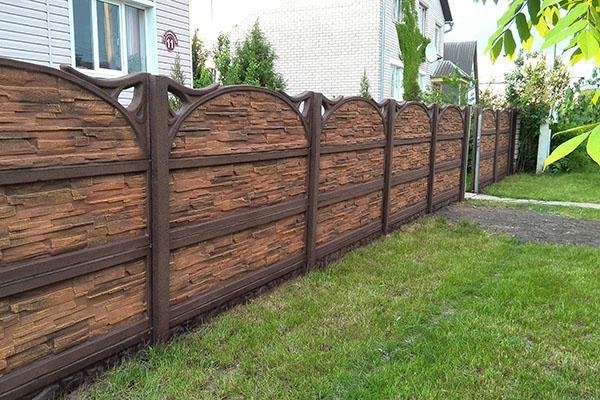How to make a concrete fence with your own hands
 Do you want to live like a stone wall? Just build a concrete fence, and your dream will come true, and it will also cost much less than a stone one. Reinforced concrete products combine two opposite characteristics of a solid fencing - a solid structure and aesthetic appearance. You can see for yourself by looking at photos of concrete fences.
Do you want to live like a stone wall? Just build a concrete fence, and your dream will come true, and it will also cost much less than a stone one. Reinforced concrete products combine two opposite characteristics of a solid fencing - a solid structure and aesthetic appearance. You can see for yourself by looking at photos of concrete fences.
Benefits of concrete fences

- exceptional strength and durability;
- the fence does not deteriorate over time, it is not affected by natural factors;
- a blank concrete fence has excellent soundproofing properties;
- if necessary, the fence can be made without joints and gaps;
- the concrete surface is easy to finish with any finishing material;
- concrete is the most economical material of all capital.
 The relative disadvantages include the large weight of the structures.
The relative disadvantages include the large weight of the structures.
The construction of such a fence will require considerable labor and the obligatory installation of the foundation.
Concrete fences differ in their manufacturing technology and functional purpose.
Monolithic fences
 This type of fence is the most durable and durable. It requires a solid or columnar foundation. The fence itself is a solid reinforced concrete slab firmly connected to the posts. Monolithic slabs can be smooth, corrugated or decorative.
This type of fence is the most durable and durable. It requires a solid or columnar foundation. The fence itself is a solid reinforced concrete slab firmly connected to the posts. Monolithic slabs can be smooth, corrugated or decorative.
Type-setting (sectional) fences
 Stacked, or sectional, fences are called, each section of which consists of several plates or panels. Plates can have different texture and decorative design. The posts for the type-setting fence on the sides have grooves into which the panels enter.
Stacked, or sectional, fences are called, each section of which consists of several plates or panels. Plates can have different texture and decorative design. The posts for the type-setting fence on the sides have grooves into which the panels enter.
The main difficulty for the construction of a sectional concrete fence is the exact installation of the posts.
The distance between them must match the length of the panel. Otherwise, the panels will not hold in the grooves or will not go there at all. As a rule, a strong foundation is made under the pillars of such a fence so that they do not warp after the freezing and thawing phase of the soil. The convenience of a type-setting fence is manifested in the assembly of panels in the grooves of concrete pillars for the fence. Each of the parts is lightweight, two or three people are enough for carrying and laying. Top panels, which are installed at a height of more than a meter, are usually made openwork. Due to the numerous holes, they become much lighter and easier to install.
Fence made of concrete blocks
 Block fences are assembled from separate solid or hollow concrete blocks, fastening them together with cement mortar. A structure of this type resembles brickwork. A fence made of blocks needs to be finished with decorative plaster or tiles with imitation of stone.
Block fences are assembled from separate solid or hollow concrete blocks, fastening them together with cement mortar. A structure of this type resembles brickwork. A fence made of blocks needs to be finished with decorative plaster or tiles with imitation of stone.
A concrete block fence does not require pillars to be installed between the individual sections, but bricklaying skills will be required for masonry.
Decorative concrete fences
 Decorative fences come in a wide variety of styles and colors.With the help of decorative concrete casting, craftsmen create durable and aesthetic compositions that are perfectly combined with other materials - wood, openwork metal forging, natural stone. Manufacturers offer many options for brickwork, stone of various textures. Concrete casting successfully imitates a balustrade and even a wooden lining. Decorative concrete fences are in great demand when fencing private property, where solidity and respectability are required first of all.
Decorative fences come in a wide variety of styles and colors.With the help of decorative concrete casting, craftsmen create durable and aesthetic compositions that are perfectly combined with other materials - wood, openwork metal forging, natural stone. Manufacturers offer many options for brickwork, stone of various textures. Concrete casting successfully imitates a balustrade and even a wooden lining. Decorative concrete fences are in great demand when fencing private property, where solidity and respectability are required first of all.
How to make a concrete fence with your own hands
 To install a concrete fence with your own hands, you will need tools and building materials:
To install a concrete fence with your own hands, you will need tools and building materials:
- steel reinforcement 4 mm for the fence and 8 mm for the posts;
- crushed stone with fractions of 2–6 cm;
- washed river sand;
- cement grade not less than M500;
- molds for casting concrete;
- plasticizer;
- concrete mixer;
- vibrating table.
 The vibrating table can be bought ready-made or made by yourself. For DIY manufacturing, a frame is welded from a metal corner and a vibration motor is fixed on it.
The vibrating table can be bought ready-made or made by yourself. For DIY manufacturing, a frame is welded from a metal corner and a vibration motor is fixed on it.
It is possible to make concrete panels without using vibration equipment, but their quality will be much lower.
Concrete panel casting technology
Crushed stone is loaded into a concrete mixer, filled with water and washed from dust and impurities. Then the water is drained and sand, cement and water are loaded. The exact proportions of the mortar for the selected brand of cement are usually written on the packaging.
Currently, there is a wide range of plasticizers on sale - special additives to give concrete certain properties or to accelerate (slow down) the setting of a solution. In the manufacture of a concrete fence, plasticizers are used to impart mobility, non-delamination and additional strength to the solution.
The casting mold is installed on a vibrating table, lubricated with mineral oil to prevent adhesion of the solution, and fittings are prepared. The reinforcement scheme must be thought out in advance, based on the features of the form. Ideally, the reinforcement should run through the entire thickness of the panel without protruding from the surface.
The mold is poured to half the volume and the vibrator is turned on. Then the reinforcement is laid, the mortar is added to the top of the mold and the concrete is compacted with a vibrator again.
At the stage of casting the mold, it is necessary to provide fasteners to connect the panel with other parts of the fence - above or below the panels or posts.
After the mortar has dried, stripping is performed - separation of the finished panel from the mold. Then the product is rubbed manually or with machines to a standard look, the mold is cleaned of concrete residues and prepared for the next pouring.
Installation of intersection pillars
 Pits about 50 cm in diameter are dug in marked places. Its depth should be no less than the depth of freezing of the soil in a given area. The bottom of the pit is tamped, covered with a layer of sand 10-15 cm and tamped again. Then the pillar is installed strictly vertically, fixed in this position and poured with concrete solution to the ground level.
Pits about 50 cm in diameter are dug in marked places. Its depth should be no less than the depth of freezing of the soil in a given area. The bottom of the pit is tamped, covered with a layer of sand 10-15 cm and tamped again. Then the pillar is installed strictly vertically, fixed in this position and poured with concrete solution to the ground level.
For complete curing of the foundation, it is necessary to withstand two weeks.
Assembling the whole structure
 The finished panels are placed in the grooves of the pillars or the reinforcement of each panel and pillars previously brought to the surface is welded together.
The finished panels are placed in the grooves of the pillars or the reinforcement of each panel and pillars previously brought to the surface is welded together.
 At this stage, the installation work on the installation of a reinforced concrete fence can be considered complete. The finished structure is additionally finished with decorative materials - plaster, facade paint on concrete, tiles. Be sure to paint over all welded parts with weather-resistant paint to prevent corrosion.
At this stage, the installation work on the installation of a reinforced concrete fence can be considered complete. The finished structure is additionally finished with decorative materials - plaster, facade paint on concrete, tiles. Be sure to paint over all welded parts with weather-resistant paint to prevent corrosion.
Fences made in this way retain all the advantages of a concrete fence. They do not absorb moisture, have low windage, excellent sound insulation, and are extremely durable.A solid concrete fence in a rural area can become a reliable barrier to grassroots fire in the spring grass palette, which leads to huge fires and human casualties.